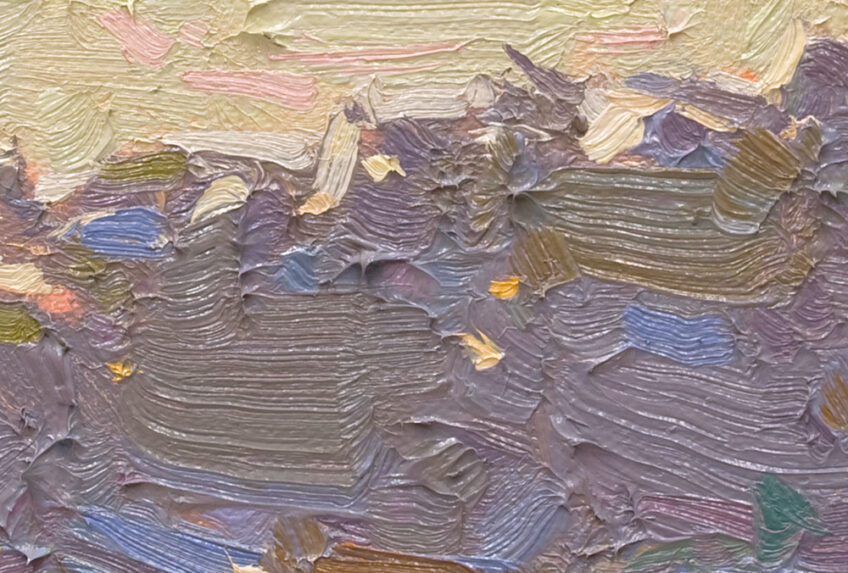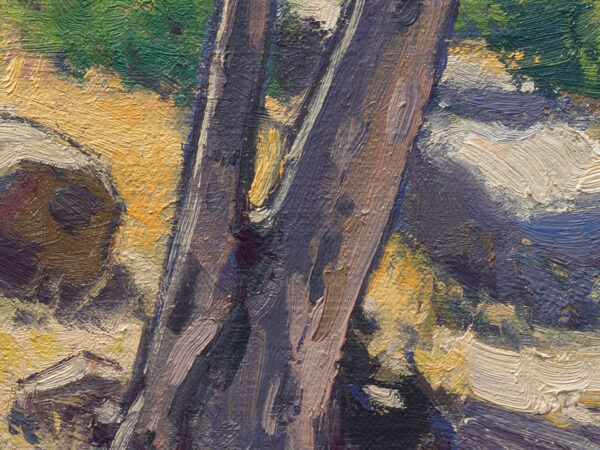We painters keep finding ways to smear paint onto canvases. Brushes are our typical tools of choice for the smearing, and brushwork is essentially what the viewer sees when they look at our paintings.
With practice over time, we can begin to get more efficient with our brushwork — saying more with less. We can give the impression of more detail with fewer brushstrokes.
Does that sound good to you? If so, here are a few ideas to improve your brushwork.
Four ways to improve your brushwork:
- Before you begin mixing your colors, spend a few minutes looking at your scene, visualizing how you want to handle each area of the painting. For example, which brush might you use to fill in the grassy meadow? How thickly or thinly do you want to apply the paint?
- While you’re painting, think about what you want each brush stroke to accomplish. Instead of mindlessly dabbing, try to have a purpose for each brush mark.
- Study works you admire by other artists (in person if possible). How did they lay down their paint? How might you apply their methods into your own work?
- Try a brushstroke counting exercise. Choose a subject and paint it using as few brushstrokes as possible. (Bigger brushes and plenty of paint will be helpful with this.) Count each stroke as you go. Then maybe do a second painting of the same scene with even fewer strokes. (Incidentally, one of my video courses at Sentient Academy demonstrates this very exercise.)
And speaking of brushes, I happen to have a great quality set available from Trekell.com. Click here to check it out.
Do you have other ideas to improve your brushwork? Leave a comment below!


12 Responses
Michael Baum
This is great advice for us all. I sometimes still find myself impatiently making several strokes where one or two considered strokes would be far more meaningful. Sometimes I’m just too lazy to reload the brush after one stroke and instead try to get in several “dabs.” When I find myself doing this, I just stop, take a breath, consider what I am doing and re-focus. This leads to a stronger painting and really doesn’t take any more time in the end. Thanks, Dan
Mark Smoot
Interesting input. I find a full size towel hanging flat in a clamping plan holder very useful for rapid brush cleaning and thinking stroke by stroke.
Dan Schultz
Thanks for the comment, Mark.
Hedy Buzan
I like to wipe off my brush regularly. This action gives me time to think, get in touch with the brush, reload with intent and keep my colors clean.
Mark Day
‘Directional’ strokes also add credence to what a painter is representing, making objects more Believable if that is your aim….while Vertical stokes in the sky are acceptable, they may not ‘lay’ right in the viewers mindset.
Good prose Dan.
Dan Schultz
Directional strokes are well worth mentioning, Mark — thanks. Makes me think of Wendt’s work and Leyendecker’s cross-hatching marks.
Dan Schultz
Thanks for the comments, Mike, Hedy and Mark. All great additional ideas. Per Mike’s “laziness” remark, I can relate!
Colleen Veneri
Thanks for your advice Dan. I never realized what a “mindless dabbler” I am but I think that I’m starting to get it. Excellent reminder.
Ian James
Hi Dan, I was looking at a painting a few days ago in which the artist had formed the background using a large brush and large strokes. It made me formulate the correlation between brush size, stroke size, and thickness of paint.
It follows one can combine thin to wide brushes with long to short (dabs!) strokes, and thin to thick paint layer, it’s an exercise I will try – keen to see the effect. And all this before we reach color and tone – there’s so much to learn.
Dan Schultz
Glad to hear that you’re seeing the possibilities, Ian. It’s all a part of what we might call “surface variety,” which I think adds more interest than handling the surface all in the same way.
Diane Edwards
Great thread. I recently took a two day “paint like Van Gogh” workshop. I think it completely changed my brush strokes from mindless to mindful. I have fallen back in love with my oil paints!
Gayle Martin
This was very informative, Dan. Thank you! I will try that exercise…